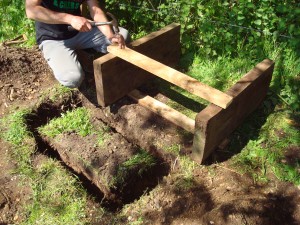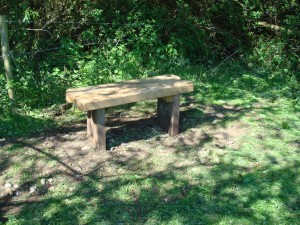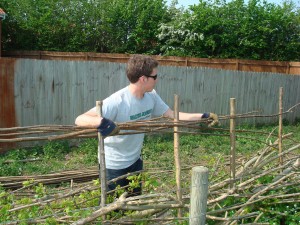Our task of the day was located at the Marston Marsh Reserve, to the south of City Centre. In order to get onto the reserve, Tom had to drive our van on a bumpy dirt path. Once we got on to the marsh, we split into two groups. The task of the first group was to remove rotting fence posts from the periphery of the marshland. During the summer, the marsh hosts several cows that keep the level of the grass down to a manageable level. Because these cows are graciously loaned by surrounding farm owners, the groundskeeper of the marsh needed to ensure that they would not escape the marsh and become sad, lost cows. I volunteered for the second group. Our task was to install a bench for the park goers. We decided to place the bench facing a small stream that runs through the marsh. First, we had to remove several branches from the area in order to make the bench accessible. Then we determined where the columns of the bench would be placed, and began digging.
Using a spade, I began digging a hole approximately one and a half feet deep. The layer of topsoil was easily removed and discarded to the side. However, the bedrock below the marsh soon proved to be extremely difficult to dig through. My accomplices used a spear shaped iron tool as leverage to separate the bedrock, which was heavily compressed into the soil. Then, I would use the spade to break up and separate the bedrock from the soil further. The rocks were difficult to remove using the spade, so I often had to remove and discard them by hand. I repeated this process several times, occasionally causing sparks from the spade hitting the bedrock. Des joked that I was lucky that there wasn’t much gas under the marsh.
Luckily, the bedrock gave way to softer clay, and we were able to insert the columns of the bench into the ground. Then, we dug two ditches that were perpendicular to the columns that had been placed into the ground. These were much more shallow than the depth that the columns needed, but we needed enough depth on the side of the columns so that side bars could be placed on the front and back of the bench. These sidebars would be buried underneath the ground, in order to make the bench too difficult to remove for any of the vandals that frequent the marsh.

A view of the ditch, and the side bars that made our bench invincible
After nailing the sidebars into the column, we placed the base of the bench back into the ditch. A support block was placed on the inside of each column, and each block was held to the column by a large gauge bolt. Using a twist drill bit, we drilled a hole for the bolt through the side of the column and the support block. Two holes were drilled on each side of the column and block, and were attached using the bolts. Then, we attached the seat of the bench to the support blocks. The seat comprised of two oak boards, which were secured onto the support blocks by first using a drill bit to make a hole, and then securing the oak boards to each support block using a large gauge bolt. After all of the bolts were secured using a washer plate and two nuts, I used a hammer to beat down the threads of each bolt, thereby preventing any thieves from removing the nuts and deconstructing the bench. Because the bench was constructed using only oak, and bolted instead of using nails, we were confident that any thieves attempting theft of the bench would give up out of frustration.

The finished bench
My palms were fairly bruised and sore from using the spade to break the bedrock, but I was satisfied that park goers would enjoy our creation for years to come. I learned that a well-maintained fence must supervise cows, for fear that they escape. I also discovered that the landscape of a marsh may look soft and lush, but the ground beneath may be tough to break through. But the most valuable lesson of the day was learning how to theft-proof a bench in a public park.
Date: 3/5/11
Time: 930 to 1330
Hours: 6 / Total: 18
Supervisor: Debbie Murray
Tags: 2010 Tyler
I woke up at eight in the morning, well prepared for my day of volunteering with the BTCV. My bag was packed with sunscreen and a water bottle, and I grabbed my bus pass to head off to City Centre. I dropped by the Tesco on Westlegate for a sarnie before heading up the hill past the John Lewis, and walked towards the BTCV office.

The field near our ivy removal task.
Our task for the day was the removal of ivy in a strip of forested land, between a housing development and a large empty field, in the vicinity of Taverham and Drayton. The large amount of ivy growth in the canopy of the forest was to be severed at the trunk of each tree. There was some debate as to whether this task would be helpful to our other conservation efforts. One volunteer argued that because birds and other animals feed on the berries that the ivy produce and use the ivy growth as a habitat, the removal of the ivy would be harmful to the wildlife in the area. However, BTCV’s funding is contingent on completing tasks for the local council, and removal of ivy was just one of these objectives. So volunteers who questioned the purpose of the ivy removal decided to keep a characteristically British “stiff upper lip” and not complain about the task once we had undertaken it. The council’s stated purpose in requesting this task was to lower the risk of trees blowing over and potentially damaging houses, due to the additional stress that the ivy’s presence would place on the trees during windy conditions.

Approximately the area where ivy was cut on each tree trunk. I'm not actually cutting the ivy in this picture, but if I was I would be wearing a glove on my left hand.
We cut the vines surrounding the trunk of each tree with a forestry tool called a billhook. The billhook is used with a swift, swinging motion to cut directly through the ivy vines. Because of risk inherent in using tools such as a billhook, all of the volunteers wore gloves on the hand opposite to the billhook. Wearing a glove with the hand holding the billhook was problematic, because it could easily slip out and cause injury. Therefore, it was best to use a bare hand to hold the billhook while cutting the ivy. We had to be sure to remove a clearly defined area, because it would be difficult for other volunteers to tell which trees had vines removed if they were only cut and not removed as well. For each tree, any vines in an area fully encircling the tree trunk were removed.
After a few hours of vine removal, we took a tea break. Compared to the first time I volunteered, the other group members were much more willing to ask me why I was in the England, as well as life in the United States. I was pretty anxious when I first volunteered at BTCV, but I could tell that the volunteers were open minded and accepting of outsiders. I also asked many of the volunteers why they had given their time to BTCV. Many of the regular volunteers were unemployed, and told me that the social atmosphere of BTCV and the presence of many other unemployed workers gave them a sense of camaraderie in working to overcome common obstacles. Many of the unemployed volunteers also stated that they felt that the conservation efforts were a positive use of their time, and that they wanted to contribute to the community, as opposed to simply collecting benefits and staying at home. Also, many of the volunteers pointed out that the experience and references would be useful on their CV, and would help them to stand out from other job applicants when the economy improved. There were also a few volunteers who were not regulars, and didn’t socialize with the group during tea break. I don’t want to speculate, but its possible that some of the volunteers were completing mandated community service programs.
There were a few more trees that needed vine removal, so after tea we got back to work. The forested strip became more overgrown with thorns and brush as we travelled further from where we started. We had to trim the thorns using our loppers, which are similar to pruning shears but are also useful for trimming small tree branches. We were able to access most of the trees in the overgrown area and complete our task. After finishing the ivy removal in the area we started, we looked for other forested areas to check for ivy as well. However, there were no more vines to be found past the area that we had completed. As a group, we took a hike down to Marriott’s Way, an abandoned railroad right of way named for William Marriott, manager of the Midland and Great Northern Railway. One of the volunteers pointed out to me the small wooden pathways that we were walking over, and explained that one of the tasks that the local council contracts out to us was the construction and maintenance of that path and others like it. After gathering our belongings, we headed back to the BTCV lodge in City Centre.

Lots of ivy everywhere.
The most interesting aspect of the task that day was that we probably would not even considered ivy removal if BTCV’s funding was directly tied to the goal. There was some debate about the usefulness of the task, and whether it would harm the wildlife in that area, but in the end we all decided to cooperate in order to secure this funding. I personally was more than willing to remove the ivy for this funding, but I can see why the volunteers with experience in forestry and ecology would see this activity as counterproductive to the goal of increased conservation. It was rewarding to listen to many of the reasons that BTCVers gave for spending their time volunteering. I also gained an understanding of BTCV as a useful social group for people who want to contribute to the improvement of Norwich as unemployed individuals, regardless of their socioeconomic circumstances.
Date: 28/4/11
Time: 930 – 1500
Hours: 5.5 / Total Hours: 12
Supervisor: Debbie Murray
Tags: 2010 Tyler
On a warm and sunny Thursday morning, I made my way to the Norwich office of the British Trust for Conservation Volunteers (BTCV for short). I left my flat for the bus stop with plenty of time to arrive, but somehow I managed to get lost among the twisting and windy streets to the south of City Centre. Finally, I gave up and called the office to ask for directions. Tom was kind enough to find me a few yards away from the pathway that lead to the entrance, which was hidden behind thick brush. After signing a few forms, I made my way through the office to introduce myself to the other volunteers.
BTCV is a voluntary organization focused on conservation and education about environmental sustainability. Volunteers help to maintain parkland for public enjoyment, as well as working on landscaping tasks that raise funds for conservation efforts. In addition to working with volunteers who have learning disabilities, the trust offers career placement and volunteer opportunities for youth and the long-term unemployed.
At 930, ten other volunteers got into a van and headed toward the western end of the Bowthorpe housing subdivision, not far from the UEA village. Our task was based in a marshland that was purchased for preservation by the property developer, as a condition for the construction of the development. That day, our objective was to heather a fence along the edge of the marshland. Heathering is the creation of a fence in a decorative and aesthetically pleasing manner, achieved by weaving long branches in and out of stakes that are set in the ground. Our work wasn’t a conservation task, but was in exchange for funding from the local council that will be used to support our conservation efforts.
To start, we used a staking ram to drive the stakes into the ground, spaced at even intervals. We had to use the staking ram with two volunteers, one on each side. This was mainly to prevent injury, but also helped us keep the stakes at a ninety-degree angle with the ground. At one point, the stakes were unevenly spaced, so we had to remove them and place them again. At times, it would be difficult to ram the stakes into the ground, because the stake would start to shift to one side or would hit a rock. In any of these cases, the stake had to be removed and replaced. After completing the staking, we decided to take a break for tea and eat our lunches. My supervisor Debbie and I had engaging conversations on the relationship between economics and ecology during these tea breaks. Also, the MP for Norwich South, Simon Wright, stopped by to join us for tea and talk to us about our conservation efforts.
After the staking was completed, we used long branches to heather the fence. To start, one volunteer would hold a branch at one end, and the other volunteer would weave the branches in and out of the stakes. If the volunteer holding the branch let go of it, the heather would fall. Shane, a more experienced volunteer, took the job of weaving the branches in and out of the stakes, while I held the end of each branch to support it. Successive branches were be added at each stake, fitting under the previous branch. Then, all of the branches that had been added were weaved in and out of the stakes. After three or four branches, the tension created would hold the heather up on its own. Heathering was much easier than driving the stakes into the ground, which required a great deal of exertion and coordinated teamwork. However, an endeavor that seemed painless soon became painful. I quickly learned how to identify stinging nettle, after putting my hand through a nettle plant while lifting a branch off the ground. However, my recovery was rapid and I was back at work within a minute.

Holding the existing heathering while Shane gets more branches.
The heather fence that we created extended about 100 metres, with a gap in the middle to make the marshland accessible to the community. At 1600, with an afternoon of work completed and a little bit of sunburn, we headed back to the BTCV lodge in the van. When I first arrived at BTCV, I had an assumption of conservation work as an abstract concept of action and tasks that are intended to help and preserve wildlife. I didn’t understand that a lot of our tasks were undertaken solely for the purpose of maintaining our other conservation efforts financially. Before I volunteered, I didn’t fully appreciate the degree to which Norwich and the areas surrounding the city rely on volunteers for the maintenance of its public spaces. On the surface, it seemed that our task was merely a means to an end. However, the sense of community and purpose that it gave the members of our group, volunteers with a wide range of abilities and life experiences, was an admirable goal in itself.
Date: 21/4/11
Time: 930 – 1600
Hours: 6.5 / Total: 6.5
Supervisor: Debbie Murray
Tags: 2010 Tyler






